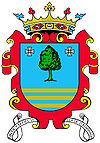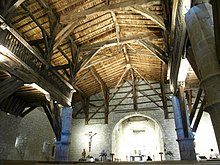Zumarraga (Basque Country)
| Zumarraga | ||
|---|---|---|

|
||
| coat of arms | Map of Spain | |

|
|
|
| Basic data | ||
| Autonomous Community : | Basque Country | |
| Province : | Gipuzkoa | |
| Comarca : | Alto Urola | |
| Coordinates | 43 ° 5 ′ N , 2 ° 19 ′ W | |
| Height : | 357 msnm | |
| Area : | 18.42 km² | |
| Residents : | 9,728 (Jan 1, 2019) | |
| Population density : | 528.12 inh / km² | |
| Founding: | 1661 | |
| Postal code : | 20700 | |
| Municipality number ( INE ): | 20080 | |
| Nearest airport : | Bilbao airport | |
| administration | ||
| Official language : | Spanish, Basque | |
| Mayor : | Mikel Serrano ( PSE-EE ) | |
| Website : | www.zumarraga.net | |
Zumarraga ( Spanish Zumárraga ) is a municipality in the province of Gipuzkoa in the Basque Country Autonomous Community in Spain . Zumarraga is the birth town of Miguel López de Legazpi , who explored the Philippines in the 16th century .
etymology
The name of the city comes from Basque and freely translated means elm village , composed of the Basque Zumar for elm and the ending -aga , which indicates a locality. A place of the same name exists in the province of Samar in the Philippines.
geography
Zumarraga is located in the upper part of the Urola Valley ( Alto Urola in Spanish ). The river forms the western border of the city, which forms a contiguous urban area with Urretxu on the other side .
history
Zumarraga is mentioned for the first time in 1366 in connection with the donation of a monastery by Henry II of Castile to the Lazkao lords . The hermitage of Santa María , which serves as a monastery, is the oldest surviving parish church in Inner Gipuzkoa. The gallery built over the remains of a fortification from the 12th century has unadorned outer walls and an artful oak roof structure that is visible from the interior .

In 1502 the conquistador Miguel López de Legazpi was born in Zumarraga , who went down in history as an explorer of the Philippines. In 1897 a statue was erected in his honor in the main square. The house where he was born, the Casa-Torre de Legazpi , has been preserved. Today it houses a music school.
Initially there was only a scattered settlement with several hamlets around the parish church, 150 m above the valley floor on the eastern slope. It was not until the end of the 15th century that the city center emerged along the river, so the clergy decided to build the new parish church of Santa María de la Asunción in the city, which would make the existing one La Antigua (Spanish for "the old one") . The town received its first municipal ordinance in 1526, the first development plan in 1860 and the market in 1865, where the agricultural products of the surrounding farms were sold. The city's water supply was established in 1901. The weekly market is still held today - every Saturday on the Plaza de Euskadi .
In 1930, the Esteban Orbegozo steel mill was relocated to Zumarraga , which created plenty of new jobs, which led to heavy immigration in the 1950s. The city's population quadrupled and reached its zenith in 1977 with 12,619 inhabitants. Then the economic crisis set in, so that an emigration began and the population was reduced to the current level.
Zumarraga was repeatedly hit by floods from the Urola - mainly due to debris that got wedged under the old bridge with only two openings during flooding. This was the case in the 20th century in 1940, 1953, 1988 and 1992. In 1994 the course of the river was rehabilitated - the old bridge was removed, the course of the river straightened and given a more gradient, for which some buildings had to give way. After that no more floods occurred.
economy
Until the beginning of the 19th century, the main source of income for the population was agriculture. With the construction of the railway lines - two in the 19th century and one in the 20th century, industrialization continued and the service sector became increasingly important.
In 1885, Justo Artiz founded the first factory for combs , wickerwork and drums . In addition to other wickerwork factories, many smaller wickerworks were also established, specializing primarily in earthen baskets made from willow and chestnut bark . The peak of wicker production was reached in the 1930s.
After the Spanish Civil War , which took place from 1936 to 1937, the Esteban Orbegozo steelworks was founded, which at times gave work to 3,000 employees and thus led to a strong increase in the city's population. Other companies followed, such as Badiola Hermanos , a manufacturer of industrial wickerwork especially for the interiors of trams and railroad cars , and later also of Badi brand combs , or the Rojo y Zaldua spring factory .
For a long time remained the from the steelworks Esteban Orbegozo emerged mill of ArcelorMittal , the last major industrial company with about 500 employees until March 2016 its closure was announced.
traffic
The railway plays an important role in the history of Zumarraga. The city was once a major railway junction with three train stations. In 1864 Norte opened the wide-gauge railway line from Madrid to the French border, which brought the city to the railway network. In 1889 the meter-gauge Ferrocarril del Deba followed by the Compañía del Ferrocarril de Durango a Zumárraga , which led over the Deskarga Pass into the Deba Valley and thus created a direct connection to Bilbao via Durango . The last new line was the Ferrocarril del Urola , also called Gure trena (Basque "our train") , which opened in 1926 . It led through the Urola valley to Zumaia . Both meter-gauge lines had the character of electrically operated overland trams on their own route . The railway through the Urola Valley in particular had many engineering structures. Zumarraga became an important railway junction in the Basque Country, which connected the Iberian Meseta with the coast of Gipuzkoa and Bizkaia . The stations of the three railways were all in the same place at the Plaza de las Estaciones (German "Platz der Bahnhof").
With the advent of private transport and the economic crisis in the 1970s, the meter-gauge routes were discontinued - in 1975 the Deba-Bahn, in 1986 the Urola-Bahn. The Renfe train station is still in operation.
Zumarraga has been connected to the Autopista AP-1 via the Autovia GI-632 since 2005 .
Culture
Zumarraga is one of the places where the Ezpata-dantza , a Basque sword dance , is practiced.
Sons and daughters of the church
- Miguel López de Legazpi (1502–1572), Conquistador
- José Ignacio Munilla Aguirre (* 1961), Roman Catholic Bishop of San Sebastián
- Aitor González Jiménez (* 1975), racing cyclist
- Mikel Balenziaga (* 1988), football player
Web links
Individual evidence
- ↑ Cifras oficiales de población resultantes de la revisión del Padrón municipal a 1 de enero . Population statistics from the Instituto Nacional de Estadística (population update).
- ↑ Ermita de la Antigua. Ayuntamiento de Zumarraga, accessed June 20, 2017 (Spanish).
- ^ The Church (Hermitage) of Santa María de la Antigua, Zumarraga. In: Blog Off the Beaten Track in the Basque Country . ToursByBasques, accessed June 21, 2017 (American English).
- ↑ 25 años sin inundaciones en Urretxu y Zumarraga. Noticias de Gipuzkoa. Retrieved June 24, 2017 (Spanish).
- ↑ En Zumarraga, hasta los calvos tenían peine. Noticias de Gipuzkoa. Retrieved June 24, 2017 (Spanish).
- ↑ Zumarraga, año uno después de Arcelor . In: diariovasco.com . March 15, 2017 ( diariovasco.com [accessed June 24, 2017]).
- ↑ De Beasain a Bergara en once minutos. Noticias de Gipuzkoa. Retrieved June 24, 2017 (Spanish).


